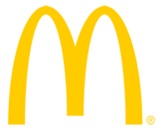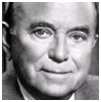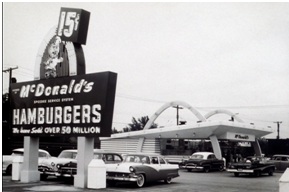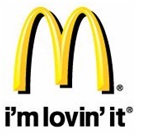|
 |
|
 |
McDonald’s - Globalization, Culture and Strategy
McDonald’s
Introduction McDonald’s is the world’s leading fast food chain with (in 2014):
Its Golden Arches logo (pictured right) has become a symbol of American global capitalism. In 2010 its profit (after paying tax) was nearly $5 billion on worldwide sales of just over $24 billion,
Key events
1955 Ray Kroc (pictured right) founds the company (as we know it today), eventually buying the business from its original owners, Richard and Maurice McDonald.
1962 The Golden Arches is introduced as the company logo.
1963 First appearance of Ronald McDonald, the clown, to appeal to children.
1968 The Big Mac introduced.
1972 The first 'drive-thru' restaurant opens in Sierra Vista, Arizona, and the Quarter Pounder introduced.
1983 Chicken McNuggets introduced.
2004 Jim Skinner (pictured right):
Super Size Me, a documentary film, is released, showing the detrimental health effects of solely eating McDonald’s food.
McDonald’s first restaurants worldwide 1955 USA (Des Plaines, Illinois) - pictured right.
1967 Canada (Richmond, British Columbia) Puerto Rico (San José).
1971 Japan (Tokyo), Netherlands (Zaandam, near Amsterdam, the first in Europe) Germany (Munich).
1974 Britain (Woolwich, London).
1979 France (Strasbourg) Brazil (Rio de Janeiro).
1990 China (Shenzhen) Russia (Pushkin Square, Moscow, the world’s busiest McDonald’s).
1992 Morocco (Casablanca), the first restaurant in Africa.
1995 Israel (first kosher restaurant in Jerusalem).
Key people Ray Kroc Kroc:
Jim Skinner Chief executive 2004-2012.
Steve Easterbrook Chief executive since 2015.
Key quotes Quality, Service, Cleanliness and Value - the company’s four key values created by Ray Kroc.
If you love what you're doing and you always put the customer first, success will be yours. - Ray Kroc
Take calculated risks. Act boldly and thoughtfully. Be an agile company, - Ray Kroc
Faster service, hotter food, greater value, in a relevant environment that our customers loved and wanted to come back to, is the answer to any question you have about the restaurant business. - Jim Skinner.
I worry about complacency. - Jim Skinner.
McDonald’s – reasons for its global success
1. Corporate culture (its shared values and beliefs) Every employee worldwide is inculcated with the company’s customer centred values and beliefs:
a) We place the customer experience at the core of everything we do Delighting each customer with outstanding QSC&V:
b) We are committed to our people Inspiring employees to delight customers through great
The company has two Hamburger Universities in America and China
c) We believe in the McDonald’s System This is the “three legged stool” of
In 2012 81% of its restaurants were owned by franchisees who run them within the company’s strict policy guidelines – see point 4.
d) We operate our business ethically (according to the highest possible standards of fairness, honesty and integrity) This assertion is strongly disputed by healthy eating campaigners. The company has had to respond with healthier eating options. For example, in Europe it has been driven by the vision of moving from “fast food to good food fast”. In 2013, the company announced that it will serve more fruit and vegetables.
e) We give back to our communities
f) We grow our business profitably (making money through delighting customers).
g) We strive continually to improve McDonald’s sees itself as a learning organization that constantly
2. Global strategy Its global management principles haven’t changed since the days of its founder, Ray Kroc:
This is often referred to as “glocalization” or “act global, think local”. Global products like French fries and burgers are complemented with local variations. Even its global brands, Big Mac, Quarter Pounder and Chicken McNuggets, are not sold everywhere. In India, for example, the Big Mac is replaced by the chicken Maharaja Mac. Global quality standards are fanatically implemented through:
a) corporate culture (see also point 1) The company’s values are at the heart of its global strategy which is summed up by its:
b) intensive staff training. All employees are trained to achieve global consistency in:
c) constant quality checks (at its restaurants and suppliers). On entering the British market in 1974, McDonald’s had to build its own bun factory, because its suppliers weren’t good enough.
d) standardization (of products, pricing and cooking procedures) French fries are cooked for exactly 3 minutes 10 seconds.
Due to falling profits, in 2003 it re-emphasized this customer driven philosophy in a new global strategy, Plan to Win that was been the strategic bedrock of Jim Skinner’s hugely successful reign as chief executive 2004-2012. It is based upon the 5 P’s: People (employees and franchisees). Products (menu variety, quality ingredients and innovation). Place (restaurant environment, convenience and opening hours). Price (affordability). Promotion
3. Localization McDonald’s modifies its products in different countries to satisfy local demand. For example:
The Chinese have a particular preference for home delivery Real fruit smoothies have been a winner with health conscious American customers.
4. Franchising Vital to the success of McDonald’s has been franchising This is selling restaurants to franchisees (who own over 80% of them) under a franchise agreement that:
This makes them:
For example, franchisees created:
Only about one per cent of applicants are chosen, and they are given an intensive nine month training programme to learn company policies and procedures.
5. Staff and structure Organization-wide global policies like quality and customer service are formulated by the company’s top management at its head office in Oak Brook, Illinois, USA. It also has four divisions that respond to changing customer requirements in each of its main markets :
Despite the company’s realization that happy employees mean happy customers, its treatment of its people has been controversial. It trains them well and pays at or above the local pay rate. But it:
Douglas Coupland (pictured right) in his book, Generation X, coined the term McJob to describe bad, lowly paid service jobs. The company has strongly defended its job record In Britain in 2007 McDonald's organized a petition (with over 100,000 signatures) to have McJob removed from the Oxford English Dictionary.
A big thank you to... McDonald’s for the logos and the restaurant photos. |
|
|
||
|
|
|
||
|
||
| Copyright © wisdomtowin.com All Rights Reserved | ||
|








